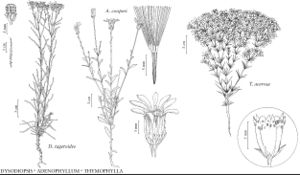Thymophylla acerosa
Sida 11: 376. 1986.
Illustrated
Basionym: Dyssodia acerosa de Candolle in A. P. de Candolle and A. L. P. P. de Candolle, Prodr. 5: 641. 1836
Revision as of 22:34, 29 July 2020 by imported>Volume Importer
Subshrubs or shrubs, green, to 25 cm, usually puberulent, sometimes glabrescent, rarely glabrous. Stems erect (branched from bases). Leaves mostly opposite; blades not lobed, linear to acerose, 10–18 mm. Peduncles 0–10 mm, puberulent or glabrous. Calyculi of 5 lance-linear bractlets, lengths 1/2+ phyllaries. Involucres campanulate to cylindric, 5–7 mm. Phyllaries ca. 13, margins of outer distinct less than 1/6 their lengths, abaxial faces puberulent or glabrous. Ray-florets 7–8; corollas lemon-yellow, laminae 5–6 × 2–3 mm. Disc-florets 18–25+; corollas pale-yellow, 3–4 mm. Cypselae 3–3.5 mm; pappi of ca. 20 scales (each a fascicle of 3–5 bristles), 3–4 mm. 2n = 16, 24.
Phenology: Flowering through the year, mostly summer–fall.
Habitat: Calcareous outcrops, gypseous soils
Elevation: 1000–2000+ m
Distribution

Ariz., Nev., N.Mex., Tex., Utah, Mexico
Discussion
Selected References
None.
Lower Taxa
None.
... more about "Thymophylla acerosa"
introrse +
connate +
herbaceous +
scarious +
absent +
hirsute +
papillate +
continuous +
decurrent +
linear;acerose +
winged;ribbed;winged;ribbed +
lance-linear +
deltate;linear +
stigmatic +
20;50 +
absent +
zygomorphic +
monomorphic +
dimorphic +
3mm;3.5mm +
staminate +
straight +
distinct +
proximal +
1;5 +
bisexual +
dispersed +
cylindric +
singly +
discoid +
indeterminate +
Present +
surrounding +
campanulate;cylindric +
5mm;6mm +
2mm;3mm +
opposite +
cauline +
distinct +
2-carpellate +
inferior +
attached +
anatropous +
persistent +
falling +
absent +
tough +
thick +
absent +
connate +
persistent +
distinct +
falling +
unequal +
Sida +
1986 +
pistillate +
absent +
fertile +
epaleate +
convex +
fibrous +
distinct +
exalbuminous +
modifed +
1;2 +
Illustrated +
alternate +
branched +
erect +
2-branched +
papillate +
Thymophylla acerosa +
Thymophylla +
species +
cylindric +
shorter +
much longer +
green;green +
